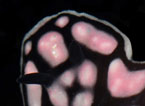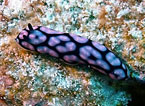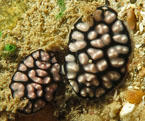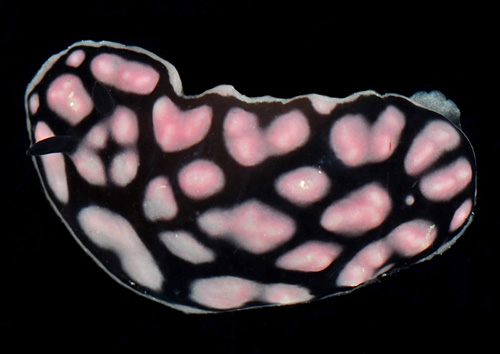| Home |
| Acknowledgments |
| Conventions |
| Glossary |
| Maps |
| References |
| Links |
| Articles |
| Thumbnails |
| Species
list |
| Family |
| Next
species |
Additional Photos

side

rhinophore sheaths

symmetric tubercles

young

mating

Phyllidiella cf. lizae Brunckhorst, 1993

| Maximum size: about 25 mm. Identification: This species is similar to Phyllidiella pustulosa with a black notum, pink tubercles, black rhinophores and a pink marginal line. However, it differs from that species in having a flatter body, lower tubercles, no black lines ascending the sides of the tubercle clusters, no pink pigment overriding the posterior margins of the rhinophore sheaths, lateral tubercle patches limited to arcs/spots (rather than circles) and paler pink coloration. The dorsal tubercles usually form symmetrical clusters around the mid-line of the notum. Natural history: Phyllidiella cf. lizae is known from several animals found in moderately exposed rocky habitats at a depth of 5-14 m (18-46 ft). Distribution: Big Island, Maui, Oahu and Kauai(?): known from Christmas Island and French Polynesia (perhaps, elsewhere in the Pacific). Taxonomic notes: While they were originally misidentified as juvenile Phyllidiella pustulosa, the DNA of the Kaneohe animals proved divergent from that species (Gustav Paulay, pers. com.). On reexamination, they were found to differ from P. pustulosa in several ways. All three of the animals were consistent with each other in those characteristics. They were also consistent with animals photographed at Christmas Island and in French Polynesia. Some photos labelled P. pustulosa on-line and in guides also appear comparable. The Big Island animal has better-defined circles of pink tubercles on the notum but otherwise matches the others. That pattern is reminiscent of some on-line photos labelled Phyllidiella lizae. However, the original description of P. lizae includes photos of animals with much more pink on the notum and the rhinophore bases. Therefore, whether or not they should be lumped is an open question. It was first recorded in Hawaii during the 2017 MarineGeo at Kaneohe Bay, Oahu by the Invert Team on May 28, 2017. Photo: Invert Team: 14 mm: 2017 MarineGeo; Kaneohe Bay, Oahu; May 28, 2017. Observations and comments: Note 1: ( ) |
| Thumbnails |
Species
list |
Family | Next species | Top |